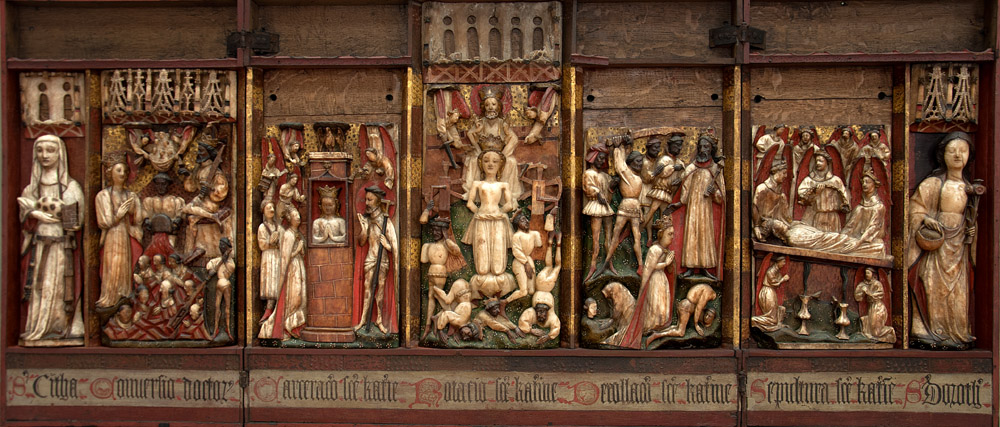St. Catherine Polyptych

English, 15th century
Painted alabaster on a wood support
Ca' d'Oro, Venice, Italy
The narrative panels are flanked by two female saints. On the right Dorothy holds her attributes, a basket and a stem of roses. On the left is St. Cointha, here spelled "Cintha." She was martyred in Alexandria during the Decian persecution of about 250. The spotted object in her right arm is probably a stone. She was first stoned and then dragged through the streets by her bound feet until she died.
The narrative panels are (left to right):
-
St. Catherine's conversion of the philosophers; their consequent execution on the orders of Maxentius, baptized by their own blood; and their conveyance to Heaven as martyrs.
See detail photo.
-
In prison, St. Catherine is visited by the Emperor's wife (on the left) and by Christ himself (on the right). During her stay a dove (above the "prison") brings her food and angels comfort her. See detail photo.
-
She is placed on the spiked wheel, but an angel destroys it. Broken pieces of the wheel fly about and kill a number of bystanders. Above Catherine, God blesses her. See detail photo.
-
On Maxentius's orders, soldiers behead Catherine. Below, left and right, are two other decapitations. The man on the right is most likely Porphyry, the soldier who accompanied the Emperor's wife when she visited Catherine and who converted with her. The decapitated figure on the left is probably the wife. One might argue that she is Catherine as seen after the sword has fallen, but her hair style is different and milk does not flow from her trunk, as was said of Catherine. See detail photo.
-
Above: Having been taken by angels to Mt. Sinai, St. Catherine's body is given Christian burial by the monks there. Below: A healing oil flows from her body. See detail photo.
View the photo above in full resolution.
Read more about images of St. Catherine.
Photographed at the Ca' d'Oro by Richard Stracke, shared under Attribution-NonCommercial-ShareAlike license.
1 See the Roman Martyrology for February 8 and the Acta Sanctorum, February vol. 2, 156.)
